Giuseppe Carenini
University of British Columbia
ChartGaze: Enhancing Chart Understanding in LVLMs with Eye-Tracking Guided Attention Refinement
Sep 16, 2025Abstract:Charts are a crucial visual medium for communicating and representing information. While Large Vision-Language Models (LVLMs) have made progress on chart question answering (CQA), the task remains challenging, particularly when models attend to irrelevant regions of the chart. In this work, we present ChartGaze, a new eye-tracking dataset that captures human gaze patterns during chart reasoning tasks. Through a systematic comparison of human and model attention, we find that LVLMs often diverge from human gaze, leading to reduced interpretability and accuracy. To address this, we propose a gaze-guided attention refinement that aligns image-text attention with human fixations. Our approach improves both answer accuracy and attention alignment, yielding gains of up to 2.56 percentage points across multiple models. These results demonstrate the promise of incorporating human gaze to enhance both the reasoning quality and interpretability of chart-focused LVLMs.
SMARTAPS: Tool-augmented LLMs for Operations Management
Jul 23, 2025Abstract:Large language models (LLMs) present intriguing opportunities to enhance user interaction with traditional algorithms and tools in real-world applications. An advanced planning system (APS) is a sophisticated software that leverages optimization to help operations planners create, interpret, and modify an operational plan. While highly beneficial, many customers are priced out of using an APS due to the ongoing costs of consultants responsible for customization and maintenance. To address the need for a more accessible APS expressed by supply chain planners, we present SmartAPS, a conversational system built on a tool-augmented LLM. Our system provides operations planners with an intuitive natural language chat interface, allowing them to query information, perform counterfactual reasoning, receive recommendations, and execute scenario analysis to better manage their operation. A short video demonstrating the system has been released: https://youtu.be/KtIrJjlDbyw
SOP-Bench: Complex Industrial SOPs for Evaluating LLM Agents
Jun 09, 2025Abstract:Large Language Models (LLMs) demonstrate impressive general-purpose reasoning and problem-solving abilities. However, they struggle with executing complex, long-horizon workflows that demand strict adherence to Standard Operating Procedures (SOPs), a critical requirement for real-world industrial automation. Despite this need, there is a lack of public benchmarks that reflect the complexity, structure, and domain-specific nuances of SOPs. To address this, we present three main contributions. First, we introduce a synthetic data generation framework to create realistic, industry-grade SOPs that rigorously test the planning, reasoning, and tool-use capabilities of LLM-based agents. Second, using this framework, we develop SOP-Bench, a benchmark of over 1,800 tasks across 10 industrial domains, each with APIs, tool interfaces, and human-validated test cases. Third, we evaluate two prominent agent architectures: Function-Calling and ReAct Agents, on SOP-Bench, observing average success rates of only 27% and 48%, respectively. Remarkably, when the tool registry is much larger than necessary, agents invoke incorrect tools nearly 100% of the time. These findings underscore a substantial gap between current agentic capabilities of LLMs and the demands of automating real-world SOPs. Performance varies significantly by task and domain, highlighting the need for domain-specific benchmarking and architectural choices before deployment. SOP-Bench is publicly available at http://sop-bench.s3-website-us-west-2.amazonaws.com/. We also release the prompts underpinning the data generation framework to support new domain-specific SOP benchmarks. We invite the community to extend SOP-Bench with SOPs from their industrial domains.
AgentAda: Skill-Adaptive Data Analytics for Tailored Insight Discovery
Apr 10, 2025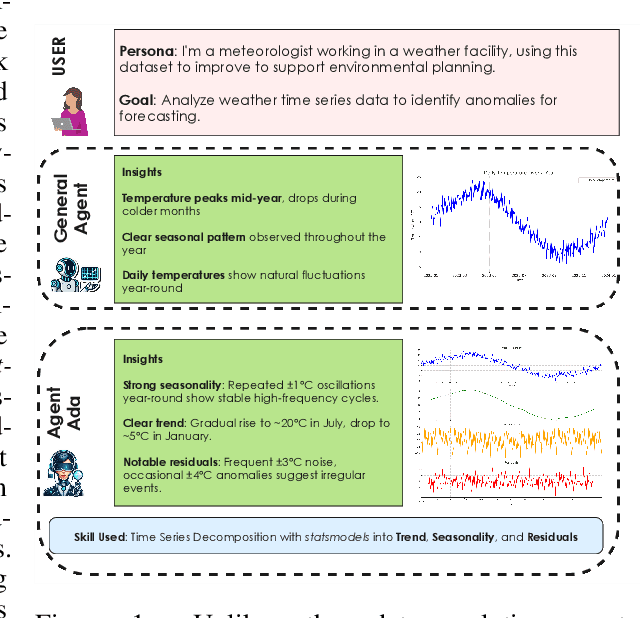

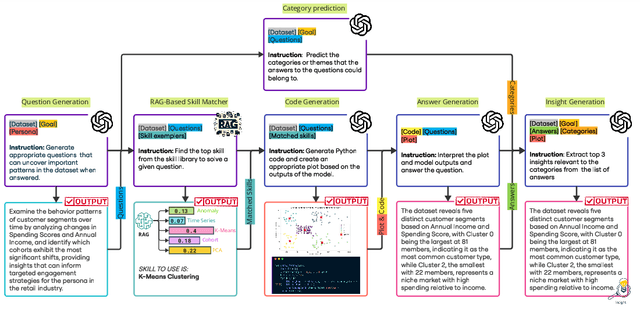

Abstract:We introduce AgentAda, the first LLM-powered analytics agent that can learn and use new analytics skills to extract more specialized insights. Unlike existing methods that require users to manually decide which data analytics method to apply, AgentAda automatically identifies the skill needed from a library of analytical skills to perform the analysis. This also allows AgentAda to use skills that existing LLMs cannot perform out of the box. The library covers a range of methods, including clustering, predictive modeling, and NLP techniques like BERT, which allow AgentAda to handle complex analytics tasks based on what the user needs. AgentAda's dataset-to-insight extraction strategy consists of three key steps: (I) a question generator to generate queries relevant to the user's goal and persona, (II) a hybrid Retrieval-Augmented Generation (RAG)-based skill matcher to choose the best data analytics skill from the skill library, and (III) a code generator that produces executable code based on the retrieved skill's documentation to extract key patterns. We also introduce KaggleBench, a benchmark of curated notebooks across diverse domains, to evaluate AgentAda's performance. We conducted a human evaluation demonstrating that AgentAda provides more insightful analytics than existing tools, with 48.78% of evaluators preferring its analyses, compared to 27.67% for the unskilled agent. We also propose a novel LLM-as-a-judge approach that we show is aligned with human evaluation as a way to automate insight quality evaluation at larger scale.
SWI: Speaking with Intent in Large Language Models
Mar 27, 2025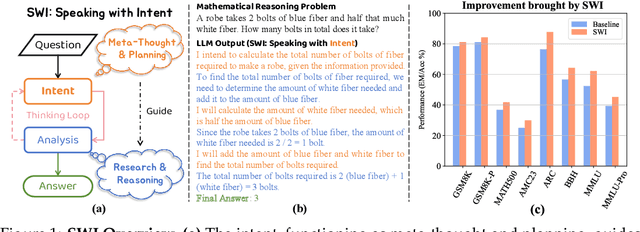



Abstract:Intent, typically clearly formulated and planned, functions as a cognitive framework for reasoning and problem-solving. This paper introduces the concept of Speaking with Intent (SWI) in large language models (LLMs), where the explicitly generated intent encapsulates the model's underlying intention and provides high-level planning to guide subsequent analysis and communication. By emulating deliberate and purposeful thoughts in the human mind, SWI is hypothesized to enhance the reasoning capabilities and generation quality of LLMs. Extensive experiments on mathematical reasoning benchmarks consistently demonstrate the superiority of Speaking with Intent over Baseline (i.e., generation without explicit intent). Moreover, SWI outperforms answer-trigger prompting methods Chain-of-Thought and Plan-and-Solve and maintains competitive performance with the strong method ARR (Analyzing, Retrieving, and Reasoning). Additionally, the effectiveness and generalizability of SWI are solidified on reasoning-intensive question answering (QA) and text summarization benchmarks, where SWI brings consistent improvement to the Baseline generation. In text summarization, SWI-generated summaries exhibit greater accuracy, conciseness, and factual correctness, with fewer hallucinations. Furthermore, human evaluations verify the coherence, effectiveness, and interpretability of the intent produced by SWI. This proof-of-concept study creates a novel avenue for enhancing LLMs' reasoning abilities with cognitive notions.
Multi$^2$: Multi-Agent Test-Time Scalable Framework for Multi-Document Processing
Feb 27, 2025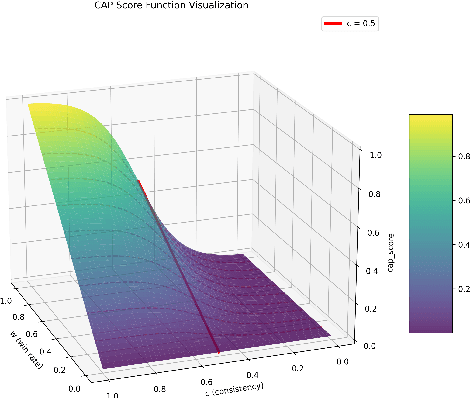



Abstract:Recent advances in test-time scaling have shown promising results in improving Large Language Models (LLMs) performance through strategic computation allocation during inference. While this approach has demonstrated strong performance improvements in logical and mathematical reasoning tasks, its application to natural language generation (NLG), especially summarization, has yet to be explored. Multi-Document Summarization (MDS) is a challenging task that focuses on extracting and synthesizing useful information from multiple lengthy documents. Unlike reasoning tasks, MDS requires a more nuanced approach to prompt design and ensemble, as there is no "best" prompt to satisfy diverse summarization requirements. To address this, we propose a novel framework that leverages inference-time scaling for this task. Precisely, we take prompt ensemble approach by leveraging various prompt to first generate candidate summaries and then ensemble them with an aggregator to produce a refined summary. We also introduce two new evaluation metrics: Consistency-Aware Preference (CAP) score and LLM Atom-Content-Unit (ACU) score, to enhance LLM's contextual understanding while mitigating its positional bias. Extensive experiments demonstrate the effectiveness of our approach in improving summary quality while identifying and analyzing the scaling boundaries in summarization tasks.
ARR: Question Answering with Large Language Models via Analyzing, Retrieving, and Reasoning
Feb 07, 2025



Abstract:Large language models (LLMs) achieve remarkable performance on challenging benchmarks that are often structured as multiple-choice question-answering (QA) tasks. Zero-shot Chain-of-Thought (CoT) prompting enhances reasoning in LLMs but provides only vague and generic guidance ("think step by step"). This paper introduces ARR, an intuitive and effective zero-shot prompting method that explicitly incorporates three key steps in QA solving: analyzing the intent of the question, retrieving relevant information, and reasoning step by step. Comprehensive experiments across diverse and challenging QA tasks demonstrate that ARR consistently improves the Baseline (without ARR prompting) and outperforms CoT. Ablation and case studies further validate the positive contributions of each component: analyzing, retrieving, and reasoning. Notably, intent analysis plays a vital role in ARR. Additionally, extensive evaluations across various model sizes, LLM series, and generation settings solidify the effectiveness, robustness, and generalizability of ARR.
Evaluating LLM Reasoning in the Operations Research Domain with ORQA
Dec 22, 2024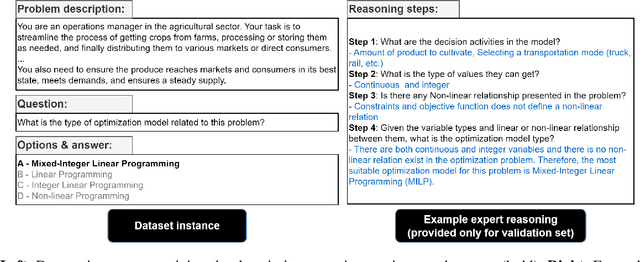


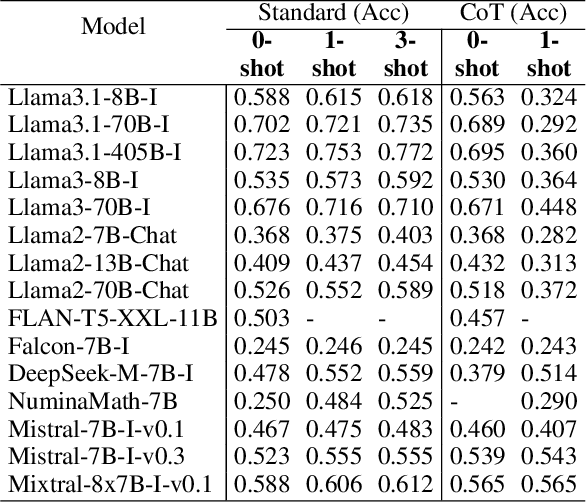
Abstract:In this paper, we introduce and apply Operations Research Question Answering (ORQA), a new benchmark designed to assess the generalization capabilities of Large Language Models (LLMs) in the specialized technical domain of Operations Research (OR). This benchmark evaluates whether LLMs can emulate the knowledge and reasoning skills of OR experts when confronted with diverse and complex optimization problems. The dataset, developed by OR experts, features real-world optimization problems that demand multistep reasoning to construct their mathematical models. Our evaluations of various open source LLMs, such as LLaMA 3.1, DeepSeek, and Mixtral, reveal their modest performance, highlighting a gap in their ability to generalize to specialized technical domains. This work contributes to the ongoing discourse on LLMs generalization capabilities, offering valuable insights for future research in this area. The dataset and evaluation code are publicly available.
FM2DS: Few-Shot Multimodal Multihop Data Synthesis with Knowledge Distillation for Question Answering
Dec 09, 2024



Abstract:Multimodal multihop question answering is a complex task that requires reasoning over multiple sources of information, such as images and text, to answer questions. While there has been significant progress in visual question answering, the multihop setting remains unexplored due to the lack of high-quality datasets. Current methods focus on single-hop question answering or a single modality, which makes them unsuitable for real-world scenarios such as analyzing multimodal educational materials, summarizing lengthy academic articles, or interpreting scientific studies that combine charts, images, and text. To address this gap, we propose a novel methodology, introducing the first framework for creating a high-quality dataset that enables training models for multimodal multihop question answering. Our approach consists of a 5-stage pipeline that involves acquiring relevant multimodal documents from Wikipedia, synthetically generating high-level questions and answers, and validating them through rigorous criteria to ensure quality data. We evaluate our methodology by training models on our synthesized dataset and testing on two benchmarks, our results demonstrate that, with an equal sample size, models trained on our synthesized data outperform those trained on human-collected data by 1.9 in exact match (EM) on average. We believe our data synthesis method will serve as a strong foundation for training and evaluating multimodal multihop question answering models.
Captioning Visualizations with Large Language Models (CVLLM): A Tutorial
Jun 27, 2024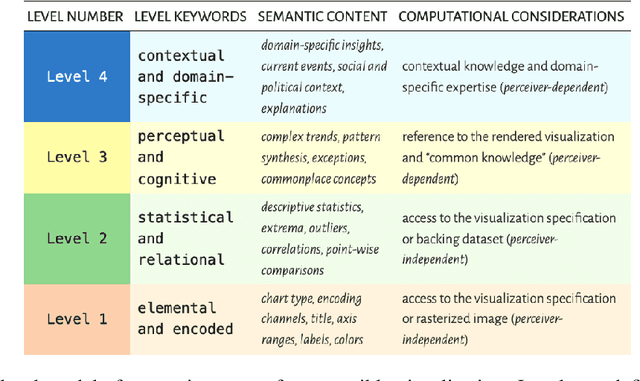
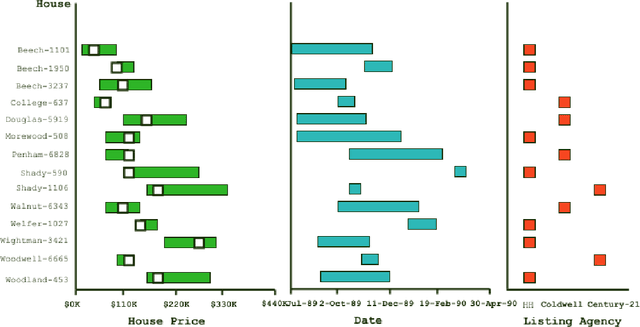
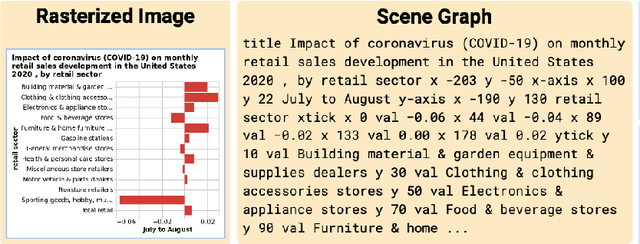

Abstract:Automatically captioning visualizations is not new, but recent advances in large language models(LLMs) open exciting new possibilities. In this tutorial, after providing a brief review of Information Visualization (InfoVis) principles and past work in captioning, we introduce neural models and the transformer architecture used in generic LLMs. We then discuss their recent applications in InfoVis, with a focus on captioning. Additionally, we explore promising future directions in this field.
 Add to Chrome
Add to Chrome Add to Firefox
Add to Firefox Add to Edge
Add to Edge